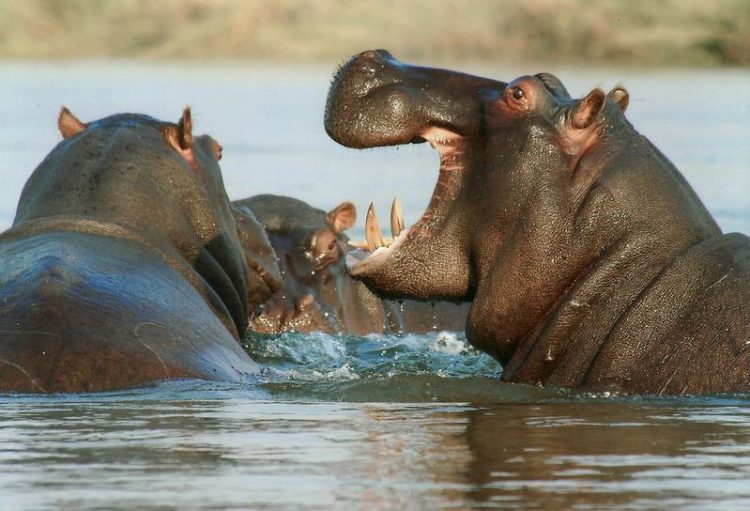Flagship species could help protect freshwaters

The hippopotamus (Hippopotamus amphibius) is one of the 132 imposing freshwater species examined that have the potential to become a flagship species. Photo: Pixabay
About one third of all animal species around the world are threatened. But even so, it is mainly the imposing, large terrestrial and marine animals such as panda bears, elephants, polar bears and whales that are perceived by the general public as being worthy of protection. And yet the decline in freshwater species is occurring more rapidly than in their popular land-dwelling and ocean-dwelling counterparts.
Imposing creatures with ambassador potential: hippos, crocodiles, sturgeons et al.
Together with her team of international researchers, IGB researcher Dr. Sonja Jähnig, co-author of the study, selected 132 examples of “imposing” large freshwater species weighing at least 30 kilos in adulthood for their study.
“Hippos, river dolphins, crocodiles, freshwater turtles and large species of fish such as sturgeons and salmon have the potential to raise public, scientific and, above all, political awareness of species loss and the attendant problems in freshwaters,” summarises Sonja Jähnig the study’s perspective.
Mapping flagship species
The researchers have mapped the occurrence of the selected species. The resulting maps show that 83 per cent of all the world’s threatened freshwater species occur in the same areas as the large freshwater species under investigation – all of which are potential ambassadors for their ecosystem. If, then, efficient protective measures for these flagship species can be identified, the habitats of numerous other smaller species could be preserved at the same time.
Protegee devoid of protected areas
Human exploitation poses a serious threat to large freshwater species: 94 per cent of the animal species under investigation suffer from over-exploitation, such as being decimated by hunting and fishing at a faster rate than stocks are able to recover. 65 percent are threatened as a result of interventions in habitats, usually due to the construction of dams, and 54 per cent suffer from pollution caused by agricultural, industrial or domestic wastewater discharges.
However, 84 per cent of the range of distribution of the 132 animal species under investigation is outside protected areas. The fact that many of these large species live in large rivers, lakes and wetlands makes conservation efforts all the more difficult, explains Dr. William Darwall, Head of the IUCN Global Species Programmes’ Freshwater Biodiversity Unit and a member of the team: “These freshwater ecosystems are highly interconnected such that the species within them and the threats to those species may travel long distances often beyond the boundaries of any protected areas.“
In order to protect these animal species – and, at the same time, entire ecosystems – local protection zones, such as for spawning and breeding sites, must be combined with large-scale landscape measures operating at the scale of the river or lake catchment, taking into account the species’ migration routes, for instance. And, above all, the exploitation of these animals and the overuse of their habitats must be curbed.
Study:
Savrina F. Carrizo, Sonja C. Jähnig, Vanessa Bremerich, Jörg Freyhof, Ian Harrison, Fengzhi He, Simone D. Langhans, Klement Tockner, Christiane Zarfl, William Darwall (2017) Freshwater Megafauna: Flagships for Freshwater Biodiversity under Threat. BioScience, Volume 67, Issue 10, 1 October 2017, Pages 919–927
Read the Studie Open Access on BioScience > https://doi.org/10.1093/biosci/bix099
Contact:
Dr. Sonja Jähnig, Leibniz-Institute of Freshwater Ecology and Inland Fisheries (IGB), Dept. Ecosystem Research, sonja.jaehnig@igb-berlin.de, +49 (0) 30 6392 4085
About the Leibniz-Institute of Freshwater Ecology and Inland Fisheries (IGB):
Work at IGB combines basic research with preventive research as a basis for the sustainable management of freshwaters. In the process, IGB explores the structure and function of aquatic ecosystems under near-natural conditions and under the effect of multiple stressors. Its key research activities include the long-term development of lakes, rivers and wetlands under rapidly changing global, regional and local environmental conditions, the development of coupled ecological and socio-economic models, the renaturation of ecosystems, and the biodiversity of aquatic habitats. Work is conducted in close cooperation with universities and research institutions from the Berlin/Brandenburg region as well as worldwide. IGB is a member of the Forschungsverbund Berlin e.V., an association of eight research institutes of natural sciences, life sciences and environmental sciences in Berlin. The institutes are members of the Leibniz Association. http://www.igb-berlin.de/en
https://freshwaterblog.net/2017/10/10/freshwater-megafauna-as-conservation-flags… > Presentation of the study on the Freshwater Blog – the freshwater biodiversity blog
http://www.igb-berlin.de/en/news/seeking-freshwater-pandas > More information about the concept of flagship species
http://www.igb-berlin.de/en/news/endangered-giants-large-freshwater-species-amon… > Background information on the endangerment of large freshwater species
Media Contact
All latest news from the category: Ecology, The Environment and Conservation
This complex theme deals primarily with interactions between organisms and the environmental factors that impact them, but to a greater extent between individual inanimate environmental factors.
innovations-report offers informative reports and articles on topics such as climate protection, landscape conservation, ecological systems, wildlife and nature parks and ecosystem efficiency and balance.
Newest articles

Hyperspectral imaging lidar system achieves remote plastic identification
New technology could remotely identify various types of plastics, offering a valuable tool for future monitoring and analysis of oceanic plastic pollution. Researchers have developed a new hyperspectral Raman imaging…

SwRI awarded $26 million to develop NOAA magnetometers
SW-MAG data will help NOAA predict, mitigate the effects of space weather. NASA and the National Oceanic and Atmospheric Administration (NOAA) recently awarded Southwest Research Institute a $26 million contract…

Protein that helps cancer cells dodge CAR T cell therapy
Discovery could lead to new treatments for blood cancer patients currently facing limited options. Scientists at City of Hope®, one of the largest and most advanced cancer research and treatment…



